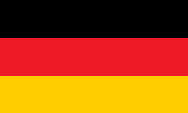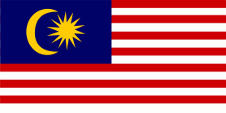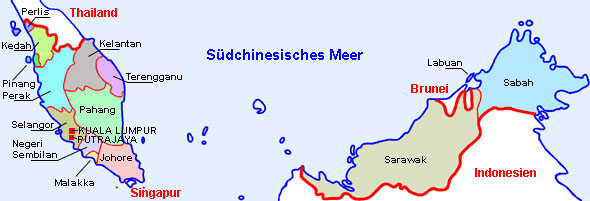mobile View, to the German Version tap the flag


- Federation of Malaysia
- federal parliamentary electional monarchy
- own name: Persekutan Tanah Malaysia
• Flags
• Historical Flags
• Meaning/Origin of the Flag
• Coat of Arms
• Meaning/Origin of the Coat of Arms
• Aircraft Roundel
• Map
• Federal States and Territories
• Numbers and Facts
• History

National flag and naval jack,
ratio = 1:2,
Source, by: Flaggen und Wappen






Merchant flag,
ratio = 1:2,
Source, by: Flaggen und Wappen




Naval flag,
ratio = 1:2,
Source, by: Flaggen und Wappen




Flag of the King,
ratio = 1:2,
Source, by: Flags of the World





1895–1941,
State flag of the Fderated Malay States,
ratio – ratio = 1:2,
Source, by:
Flags of the World




1895–1941,
Naval jack of the Federated Malay States,
ratio – ratio = 1:2,
Source, by:
Flags of the World




1911–1936,
Flag of the Chief Secretary of the Federated Malay States,
ratio – ratio = 1:2,
Source, by:
Flags of the World




1936–1942,
Flag of the High Commissioner of the Federated Malay States,
ratio = 1:2,
Source, by:
Flags of the World




1946–1948,
State flag of the Malay Union,
ratio = 1:2,
Source, by:
Flags of the World




1948–1950,
State flag of the Malay Federation,
ratio = 1:2,
Source, by:
Flags of the World




1950–1963,
State flag of the Malay Federation,
ratio = 1:2,
Source, by:
World Statesmen




The today's flag of Malaysia is assembled after the model and principle of the flag of the USA and is based on the flag of the Malay Federation. It consists of 14 horzontal red and white stripes. Sie blue upper staff quadrant shows a yellow crescent and a 14-pointed yellow star. The number 14 stands for the membering states of the federation. The flag was maintained even after the withdraw of Singapore. The spare star-point respectively flag-stripe stands now for the federal territories. This flag was introduced on the 16th of September in 1963, as 11 Malay states join with Sabah, Sarawak and Singapore to the Confederation of Malaysia. The colours of the flag are to interprete in twice ways:
• Red and white are the Malay national colours, yellow represents the sultanates in the confederation, blue remembers the long British influence. Star and crescent are Islamic symbols.
• Yellow stands for the individual sultanates and the colours blue, white and red have their roots in the colours of United Kingdom. Star and crescent are Islamic symbols.
The flag of the Yang Di-Pertuan Agong (Chief of State/Electional King) is yellow with the coat of arms in a rice ear wreath in the center. Malaysia is orientated in the British ensign system. This points to the former colonial bonds to United Kingdom. United Kingdom introduced a flag system in 1864 in which:
• war ships fly the "White Ensign" (naval flag), a white flag often with an uninterrupted red St. George's-Cross and with the Union Jack in the upper staff quadrant of the flag,
• merchant ships fly a "Red Ensign" (also named "Civil Ensign" → civil flag, the real merchant flag), a red flag with the Union Jack in the upper staff quadrant of the flag, and
• governmental ships fly the "Blue Ensign" (flag for the use by the gouvernment → the actual state flag), a blue flag with the Union Jack in the upper staff quadrant of the flag.
The Malay states, which mostly exist untill today, had and have a variety of own flags, e.g. own national flags, merchant flags or even naval or war flags. Its history of nascence has its roots mostly in influences from outside. The states Kelantan, Terengganu, Kedah and Perlis belonged initially to Siam (Thailand). Kedah and Perak belonged in the 17th century in passing to the Sultanate of Aceh and had adoped its red flag. Perlis had its own colours and Kelantan and Terengganu had since 1832 – the year when both states released partially from Siam – single-coloured white flags. A furthermore mighty state which had big influence in this region was the Sultanate of Lingga. Lingga had a single-coloured black flag and consisted of the Archipelago of Linga, the today's Singapore and the today's Johore. The State of Pahang was dependent from Lingga and used its black flag, but supplemented by a white stripe at the leech. Terengganu also startet to use its white flag by black supplementations. The colours red, black, white and yellow so have been the dominating colours of the Malay flag history. In this way it is not astonishing that this colours were in use Farben in the flag of the diverse Malay confederations:

1895–1941 • Federated Malay States
1946–1948 • Malay Union
1948–1950 • Malay Federation

The Malay Union was reorganized in 1948 and converted to the Malay Federation under a British High Commissioner, which reached the independence from United Kingdom in 1957 as the Kingdom of the Malay Federation. In 1963 was the founding of the Kingdom of Malaysia. The from 1948 common politics in foreign affairs and economy made the naval and even the merchant flags of the membering states unnecessary. Their national flags, however, were able to keep up until today. The colours not only represent the old single - coloured flags of the Malay states. They have futhermore an quite own meaning in Malaysia: Red stands often for the people and white for the sovereign. The sovereigns of the Malay states – which at that time have been mostly Rajahs or Maharajahs - thus used white flags. Its proconsuls or Prime Ministers (Temenggong) showed yellow flags and the Second Ministers (Bendahara) used black flags. Sometimes is yellow the colour of the sovereign and white the colour of the Temenggong. In this way they conformed in the tradition of this region of the world, that actually the colour yellow represents the king and its dignity. The combination of white and red counts for the Malay national colours, but they are spreaded in the whole Indonesian Malaysian and Polynesian area as national colours.
Source:
Die Welt der Flaggen,
Flaggen Wappen Hymnen,
Flaggen-Atlas Erde,
Die Welt im bunten Flaggenbild,
Volker Preuß


Coat of arms of Malaysia,
Source, by:
Corel Draw 4

The coat of arms shows from two tigers supported blazon. It bases on the colours of the old federated states, with fields for Melacca and Penang and a head of shield with five Kris (curved daggers) for the historical non-federated states. Below the blazon a banner with the motto of the state: "Bersekutu Bertambah Mutu" → "Unity makes strong". In 1963 were added fields for Singapore, Sabah and Sarawak. Between the symbols of Sabah und Sarawak is positioned since 1967 a hibiscus bloom. It compensates for the symbol of Singapore, which leaved in 1965 the federation. As soon as there changes the coat of arms of a partly state has to change the corresponding field on the federal coat of arms. This was hitherto the case right frequently.
Source:
Die Welt der Flaggen,
Flaggen Wappen Hymnen,
Flaggen-Atlas Erde,
Volker Preuß


since 1982
Aircraft Roundel,
Source, by: Wikipedia (EN)

Location:

Source: CIA World Factbook
Map of the country:

Source: CIA World Factbook

Map: Volker Preuß

Federal States
"Federated Malay States":
• Perak
• Pahang
• Selangor
• Negeri Sembilan
"Non-Federated Malay States":
• Kedah
• Perlis
• Kelantan
• Terengganu
• Johore
former "Straits Settlements":
• Malakka
• Pinang
incorporated in 1963:
• Sabah
• Sarawak
Federal Territories
• Kuala Lumpur
• Putrajaya
• Labuan

Area: 127.525 square miles
Inhabitants: 32.400.000 (2020), thereof 50% Malay, 23% Chinese, 11% native tribes (Senoi, Semang ...), 7% Indians
Religions: 61% Muslim, 20% Buddhist, 9% Christian, 6% Hindu
Density of Population: 254 inh./sq.mi.
Capital: Kuala Lumpur, 1.982.112 inh. (2020)
official Language: Malaysian (Bahasa Malaysia)
other Languages: Chinese, Tamil, English
Currency: 1 Ringgit (MYR, R) = 100 Sen
Time Zone: GMT + 8 h
Source:
Wikipedia (D)

7th–12th cent. · Western Malaysia (Malaya) to the Shrividjaja Empire
14th–15th cent. · to the Madjapahit Empire
15th cent. · nascence of the Malay States in Malaya
16th cent. · Portugese attempts of colonization in Malaya
17th cent. · local Dutch colonization in Malaya
1786 · the British (East India Company) establish in Penang, 1800 follow Wellesley, 1819 Singapore, 1824 Malacca, 1826 Pankor
1824 · the Netherlanders leave Malaya
1826 · the British possessions of the East India Company become summarized to the "Straits Settlements"
1873–1888 · United Kingdom establishes the protectorate over four Malay States (Perak, Pahang, Selangor, Negeri Sembilan)
1895 · Perak, Pahang, Selangor, Negeri Sembilan become summarized to the "Federated Malay States" (until 1941)
1909 · Siam (Thailand) has to cede the Malay States Perlis, Kedah, Kelantan und Terengganu (until that point in time only casual Siamese supremacy) officially to United Kingdom → "Non-Federated Malay States"
1941 · Japanese conquest
1945 · withdrawal of the Japanese
1st of April 1946 · formation of the Malay Union by confederation of the Malaysian Sultanates (British protectorates) and the Straits Settlements (British crown colonies), but without Singapore. The Straits Settlements become partially as independent Malay States to British protectorates (Malakka, Penang), partially they become incorporated to the Malay State of Perak (Pankor, Dindings)
1st of February in 1948 · re-organization of the Malaysian Union, creation of the Malaysian Federation under a British High Commissioner
31st of August 1957 · independence and proclamation of the Kingdom of Malaysian Federation
16th of September 1963 · proclamation of the Kingdom of Malaysia by confederation of the Malaysian Federation (Malaya) with the former British colonies Sarawak, Sabah (North Borneo) and Singapore. Brunei rejects the joining and remains at United Kingdom
9th of August 1965 · Singapore leaves the Federation of Malaysia
1993 · constitutional reform, the Sultanates lose partially their independence
Source:
Atlas zur Geschichte,
Weltgeschichte,
Discovery '97,
Wikipedia (D)

Kindly supported by: E. Hoheisel (D)

![]()





























